AMD Ryzen 9 5980HS Cezanne Review: Ryzen 5000 Mobile Tested
by Dr. Ian Cutress on January 26, 2021 9:00 AM EST- Posted in
- CPUs
- AMD
- Vega
- Ryzen
- Zen 3
- Renoir
- Notebook
- Ryzen 9 5980HS
- Ryzen 5000 Mobile
- Cezanne
CPU Tests: Legacy and Web
In order to gather data to compare with older benchmarks, we are still keeping a number of tests under our ‘legacy’ section. This includes all the former major versions of CineBench (R15, R11.5, R10) as well as x264 HD 3.0 and the first very naïve version of 3DPM v2.1. We won’t be transferring the data over from the old testing into Bench, otherwise it would be populated with 200 CPUs with only one data point, so it will fill up as we test more CPUs like the others.
The other section here is our web tests.
Web Tests: Kraken, Octane, and Speedometer
Benchmarking using web tools is always a bit difficult. Browsers change almost daily, and the way the web is used changes even quicker. While there is some scope for advanced computational based benchmarks, most users care about responsiveness, which requires a strong back-end to work quickly to provide on the front-end. The benchmarks we chose for our web tests are essentially industry standards – at least once upon a time.
It should be noted that for each test, the browser is closed and re-opened a new with a fresh cache. We use a fixed Chromium version for our tests with the update capabilities removed to ensure consistency.
Mozilla Kraken 1.1
Kraken is a 2010 benchmark from Mozilla and does a series of JavaScript tests. These tests are a little more involved than previous tests, looking at artificial intelligence, audio manipulation, image manipulation, json parsing, and cryptographic functions. The benchmark starts with an initial download of data for the audio and imaging, and then runs through 10 times giving a timed result.
We loop through the 10-run test four times (so that’s a total of 40 runs), and average the four end-results. The result is given as time to complete the test, and we’re reaching a slow asymptotic limit with regards the highest IPC processors.
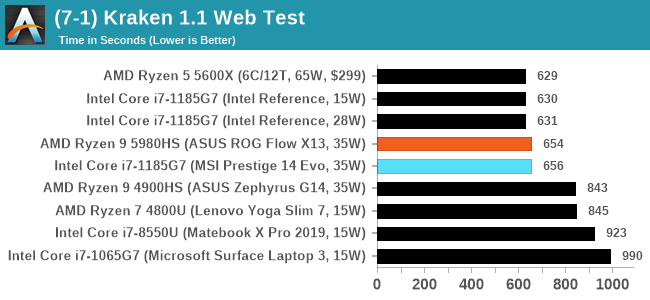
Google Octane 2.0
Our second test is also JavaScript based, but uses a lot more variation of newer JS techniques, such as object-oriented programming, kernel simulation, object creation/destruction, garbage collection, array manipulations, compiler latency and code execution.
Octane was developed after the discontinuation of other tests, with the goal of being more web-like than previous tests. It has been a popular benchmark, making it an obvious target for optimizations in the JavaScript engines. Ultimately it was retired in early 2017 due to this, although it is still widely used as a tool to determine general CPU performance in a number of web tasks.
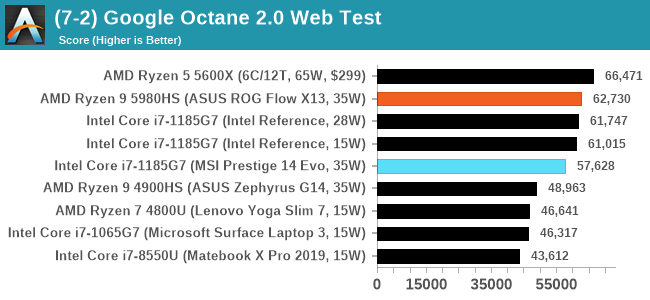
Speedometer 2: JavaScript Frameworks
Our newest web test is Speedometer 2, which is a test over a series of JavaScript frameworks to do three simple things: built a list, enable each item in the list, and remove the list. All the frameworks implement the same visual cues, but obviously apply them from different coding angles.
Our test goes through the list of frameworks, and produces a final score indicative of ‘rpm’, one of the benchmarks internal metrics.
We repeat over the benchmark for a dozen loops, taking the average of the last five.

Legacy Tests
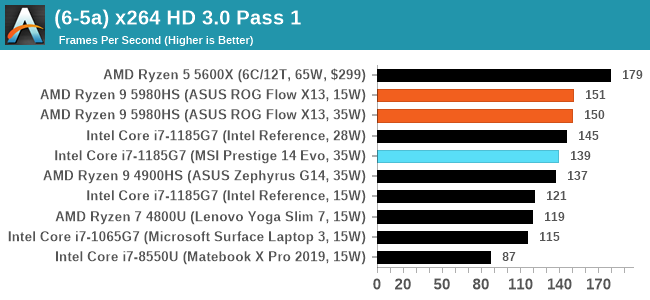
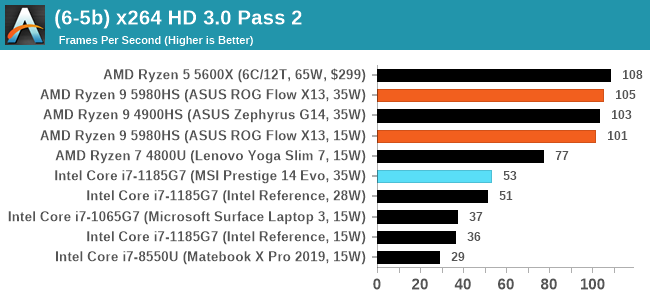
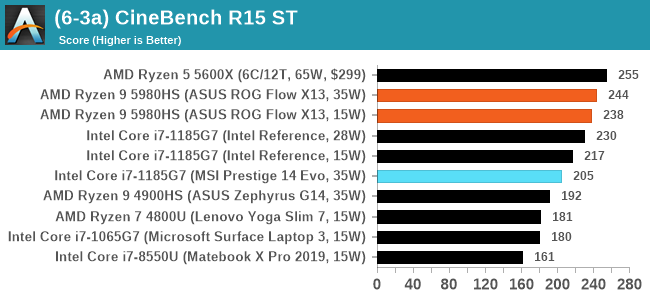
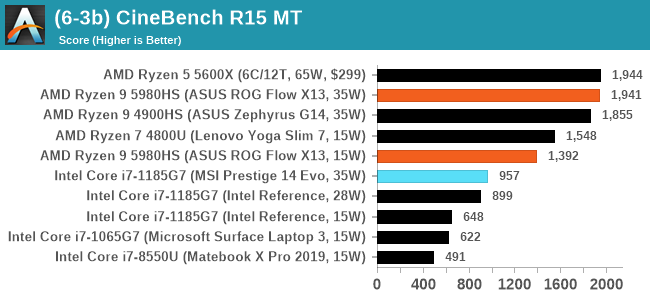


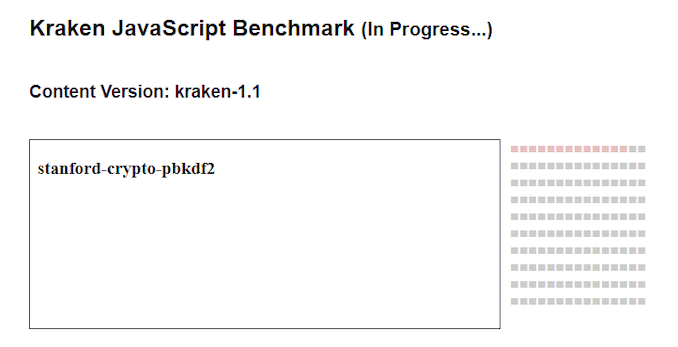
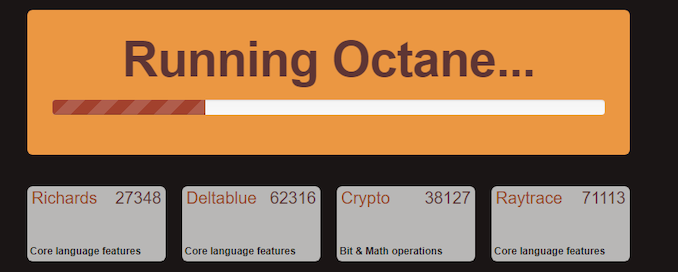









218 Comments
View All Comments
Smell This - Tuesday, January 26, 2021 - link
LOL @ ZoZo ___ he is messin' with you, ts
You are correct in that Dr Su and AMD has played yet another "Rope-A-Dope" on the competition. I suspect RDNA2/Navi II will raise its pretty head after the "Lexa" cores run their course. It has been a productive run.
There are Radeon pro CNDA1 cores floating around that will likely evolve into the RX 6500 RDNA2/Navi IIs discreet replacements for Lexa. These will be the Display Core Next: 3.0 // Video Core Next: 3.0 arch associated with the Big Navi.
And ... I don't think AMD is being lazy. I think the Zen2/Zen3 APU product stack is being developed as yet to be revealed. Home / Office / Creator ? There is a Radeon Pro Mac Navi Mobile with RDNA1 discreet video w/HBM2.
We will see how the 6xxx APUs evolve. Grab your popcorn!
TelstarTOS - Tuesday, January 26, 2021 - link
lazy, definitely lazy.vortmax2 - Saturday, January 30, 2021 - link
One sees lazy, another sees smart business decision.samal90 - Friday, February 12, 2021 - link
The APU in 2022 will use RDNA 2 finally. Expect a substantial GPU performance lift next year with the new Rembrandt chip.Spunjji - Thursday, January 28, 2021 - link
A console APU is not a PC APU - they have completely different design constraints and memory architectures. Vega was used here because it allowed AMD to bring Zen 3 APUs to market faster than they managed with Zen 2 - it's all mentioned in the review that you're commenting on......sandeep_r_89 - Friday, January 29, 2021 - link
The consoles don't use iGPUs.......most likely, RDNA2 design so far hasn't been designed for low power usage, it's focused more on high performance. Once they do the work to create a low power version, it can appear in iGPUs, laptop dGPUs, low end desktop dGPUs etc.Netmsm - Tuesday, January 26, 2021 - link
any hope for Intel?Deicidium369 - Wednesday, January 27, 2021 - link
LOL. Any hope for AMD?Releases Zen 3, RDNA2 and consoles - and only grows revenue $240M over Q3.... Didn't even gross $10B last year.
Meanwhile Intel posts 5 YEARS of record growth...
Spunjji - Thursday, January 28, 2021 - link
A discussion of a company's technological competitiveness is not a discussion of their financial health. Any dolt knows this, why do you pretend we can't see you moving the goalposts in *every single comment section*?Spunjji - Thursday, January 28, 2021 - link
This post is even more hilarious in the context of AMD's financial disclosure today 😁